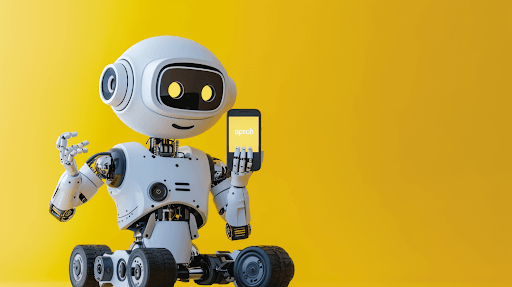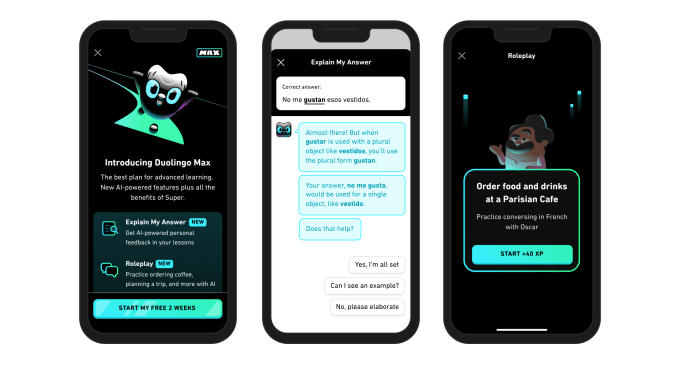In a recent interview, OpenAI Co-founder and CEO Sam Altman revealed that 100 trillion words are published daily worldwide on the Internet today, and at least 100 billion of them are credited to OpenAI’s chatbots.
Generative AI is like a creative robot that makes all sorts of new things—chat replies, designs, and even videos. It comes in handy for coming up with fresh ideas in creative areas and solving new problems. With over 180 million users of ChatGPT alone, this automation is helping not only individuals but whole enterprises to streamline their tasks and have an exponential growth rate.
For example, Snap Inc.’s Snapchat introduced “My AI,” a GPT-powered chatbot customized for friendly, personalized one-on-one or group conversations, offering advice, jokes, and guiding users through app features, even providing information on unconventional topics like local recommendations.
The power of Generative Artificial Intelligence (Gen AI), which is expected to grow globally to an industry size of $22 billion by 2025, cannot be ignored.
Let us understand this herculean concept of Gen AI that the world has become obsessed with.

The Evolution of Generative Artificial Intelligence (Gen AI):

Going back to 1966, we meet ELIZA, a conversational chatbot from the Massachusetts Institute of Technology. Created by computer scientist Joseph Weizenbaum, it was programmed to generate generic responses and struggled to keep up with and understand conversations.
Jumping ahead to 2011, Apple launched its one of a kind voice assistant ‘Siri’, which could generate voice and take actions in response to voice commands.
Moving forward, we land in 2014, where we see the paradigm-shifting introduction of Generative Adversarial Networks (GANs) by researcher Ian Goodfellow. Based on specific Machine Learning (ML) algorithms, these help generate a variety of data types, including text, images, and audio.
In 2018, OpenAI launched the Generative Pre-Trained Transformer (GPT), which was trained on 40 gigabytes of data to generate human-like content in various forms like text, images, etc. It further paved the way for forming Large Language Models (LLMs).
And recently, in the early 2020s, we saw the launch of OpenAI models, starting from Dall-E to ChatGPT. And many other competing platforms, including Gemini (formerly known as Bard ), Llama, Stable Diffusion, Copilot, etc.
Generative Artificial Intelligence (Gen AI)
Gen AI is a subset of AI Machine Learning technologies, which are further a subsection of AI that is trained on data and teaches the system to make predictions.
The text-oriented conversational AI is able to create human-like text, audio, image, and video content in response to text prompts instantly based on the data it is trained on.
For example, Duolingo employs a ChatGPT-powered bot, offering foreign language learners in-depth explanations on practice test answers, replicating a human tutor interaction for enhanced understanding.

Now, the question “Where does this training data come from?” arises.
Data Sources of Generative Artificial Intelligence (Gen AI)
Gen AI is trained on diverse data sources and possesses a versatile understanding of language and context.
- Web Scraping and Crawling: Gen AI gathers information by automatically extracting data from websites, enabling it to learn from a wide range of online sources.
- Public Data Sets: Publicly available datasets are utilized to enhance the AI’s understanding of diverse topics, incorporating information from various domains into its training data.
- Crowdsourcing: Gen AI uses contributions from a distributed group of individuals, incorporating diverse perspectives and data points gathered through crowd collaboration.
- Synthetic Data Generation: Artificial data is created to supplement its training, allowing it to simulate scenarios and broaden its capacity to generate content in various contexts.
- Customer Data: The AI incorporates information provided by users or customers, adapting its responses based on the specific data it receives from individual interactions.
- User-Generated Content (UGC): Gen AI learns from content generated by users, incorporating the language, style, and nuances found in the user-created text, audio, image, and video content.

Working of Generative Artificial Intelligence (Gen AI)
Generative AI models are meticulously designed by developers who understand their detailed workings, including neural network structures and training processes. However, the intricate processes within the neural network layers, which lead to the models’ creative outputs, remain too complex for full comprehension.

Here is an overlook of the process:
- Neural Network Architecture: Generative AI models, like GPT 4 / 3.5, start with artificial neural networks encoded in software. The neurons, arranged in layers similar to the brain, have connections with varying strengths known as weights or parameters.
The transformer architecture, well-suited for large language models, is prominent in generative AI. - Training the Model: Neural networks are trained using vast amounts of text data, making predictions such as the next word in a sequence. Through human feedback and backpropagation algorithm, the model adjusts its parameters based on correctness against the training data.
After trillions of tokens, the model becomes adept at predicting and generating coherent sequences. - Fine-Tuning: Post-initial training, generative AI models can be fine-tuned using techniques like reinforcement learning from human feedback (RLHF). In RLHF, human reviewers assess the model’s output, providing binary feedback that influences further refinement.
- Achieving General Intelligence: Controversially, researchers suggest that advanced models like GPT-4 exhibit a form of general intelligence. GPT-4 seemingly builds an internal model of the world and responds intelligently to diverse challenges, showcasing a broad range of expertise, albeit with internal processes still not fully understood.
These models operate akin to human brains, continuously predicting and learning from disparities between predictions and reality. Despite empirical understanding, the internal processes within the neural network layers, specifically what the model “thinks” during processing, remain largely unknown and complex beyond current analytical capabilities.
Generative Artificial Intelligence (Gen AI) Models
The initial versions of Generative AI began by requiring developers to submit data through API and build expertise in development tools and languages. However, the process has evolved to be model-centric, relying on advanced frameworks.
These models are trained on diverse datasets. The AI’s proficiency in creating contextually relevant responses stems from its ability to discern patterns and relationships within the vast amounts of data it has been exposed to during training.
Let us discuss the key approaches to building the Gen AI models:
- Diffusion Models: Diffusion models, a class of generative models, center on the temporal evolution of data, emphasizing the gradual diffusion of information within a system.
Tailored for tasks involving temporal dynamics and sequential data, these models, such as those applied in video prediction, excel at forecasting the next frames in a sequence.
Their prowess lies in capturing the evolving nature of data over time, making them particularly effective for applications requiring an understanding of temporal dependencies and sequential patterns.
- Transformers: Transformers are a type of neural network architecture that has proven highly effective in natural language processing and other sequence-to-sequence tasks. They use self-attention mechanisms to process input data in parallel, allowing efficient learning of long-range dependencies.
Widely exemplified by models like GPT (Generative Pre-trained Transformer), Transformers are adept at producing coherent and contextually relevant text-based outputs, showcasing their versatility in generating high-quality language-based content across various applications.
- Generative Adversarial Networks: GANs consist of two neural networks, a generator and a discriminator, engaged in a competitive training process. The generator aims to produce realistic data, while the discriminator’s role is distinguishing between real and generated samples.This adversarial setup results in the generation of high-quality synthetic data. GANs are widely used for image synthesis, style transfer, and creating realistic-looking content across various domains.
- Recurrent Neural Networks: RNNs are a specialized type of neural network tailored for sequential data processing, featuring a recurrent structure that preserves a hidden state carrying information from preceding time steps. This design renders them particularly apt for tasks involving temporal dependencies.
RNNs have found application in generating sequences, demonstrating their utility in tasks like natural language generation and music composition, where capturing sequential patterns and context is crucial for producing coherent and meaningful outputs.
- Variational Autoencoders: VAEs seamlessly integrate generative and variational inference elements. Comprising an encoder mapping input data to a probabilistic latent space and a decoder reconstructing input from samples within this space, VAEs are versatile.their application, particularly in tasks like image generation, showcases their ability to generate diverse and realistic variations of input data, making them valuable for tasks requiring the synthesis of high-quality visual content.
Each of these approaches offers unique advantages and is suited to different types of generative tasks, contributing to the diverse landscape of Generative AI models.
Generative Artificial Intelligence (Gen AI) Tools
From conversation and code generation to creative writing and design, these tools redefine human-computer interaction.
Conversational AI:
- ChatGPT: An advanced conversational AI model developed by OpenAI for generating human-like text in response to prompts.
- Jasper AI: A generative AI tool that uses natural language understanding to generate dynamic and interactive responses.
- Bing Chat: A chat-based interface developed by Microsoft that utilizes natural language processing for interactive conversations.
- ChatSonic: An AI tool for creating interactive conversational agents that can be integrated into applications and platforms.
- Cohere Generate: A language model tool that allows developers to integrate natural language understanding into applications.
Code Generation:
- GitHub Copilot: An AI-powered code completion tool by OpenAI and GitHub that assists developers in writing code snippets.
- AlphaCode: An AI tool designed for code generation, assisting developers in automating programming tasks.
- Amazon CodeWhisperer: AI tool designed to assist developers in generating and improving code snippets.
Text Generation:
- Bard: A creative writing AI tool that generates poetry and prose based on user prompts.
- Wordtune: An AI-powered writing assistant that provides suggestions and improvements for written content.
- Copy.ai: An AI-powered writing tool that generates creative and contextually relevant text based on user input.
- Cogram: An AI tool that generates coherent and contextually relevant text based on user prompts.
- Descript: An AI-powered audio and video editing tool that transcribes and allows users to manipulate media content using text-based commands.
- Contentmate.ai : An AI-powered tool which generates SEO-optimized and plagiarism-free content for blogs, ads, emails, and website. Read more.
Music Composition:
- Claude: An AI tool for generating music compositions and melodies using deep learning techniques.
- Amper: A music composition AI tool that generates musical pieces and accompaniments for various purposes.
- AIVA: AI tool that composes classical music compositions using deep learning techniques.
- MuseNet: An AI music generation tool by OpenAI that creates diverse musical pieces across different genres.
Visual Content Generation:
- Synthesia: Known for AI-generated synthetic media, particularly deepfake videos with realistic face and voice synchronization.
- Stable Diffusion: A generative AI model designed for tasks involving temporal dynamics and sequential data, particularly image and video prediction.
- DALL-E: Developed by OpenAI, DALL-E is a generative model capable of creating diverse and imaginative images from textual descriptions.
- Design generators (DreamStudio): AI tools that assist in generating visual design elements, possibly including images, graphics, or layouts.
- Magic Eraser: An AI tool focused on removing unwanted elements from images through automated editing.
- Midjourney: A tool focused on generating visual content or images using generative AI techniques.
Collaborative Writing:
- Duet AI: An AI tool designed for collaborative writing, enabling users to co-create content with AI assistance.
Question-Answering:
- AskCodi: An AI-powered question-answering tool designed to provide informative and context-aware responses.
Multifunctional Platforms:
- MutableAI: A platform providing access to various AI models for different applications, including natural language processing and image generation.
- InVideo: An AI-based video creation tool that facilitates the generation of engaging and professional-looking videos with minimal effort.
With each tool offering a unique perspective, the collective impact underscores the transformative potential of Generative AI in shaping the way we interact, create, and innovate in the digital landscape.
Generative Artificial Intelligence (Gen AI) Use Cases
Gen AI emerges as a transformative force across industries, streamlining tasks, enhancing communication, and unlocking new possibilities in various modalities and applications.
Healthcare:
- Medical Imaging Analysis: Generative AI assists in analyzing medical images, identifying abnormalities, and providing recommendations for treatment based on patient history.
- Automated Medical Coding/Billing: Streamlining administrative tasks by automating medical coding and billing processes, allowing healthcare professionals to focus on patient care.
Technology and Software Development:
- Code Generation and Troubleshooting: Generative AI aids software engineers in generating code snippets, troubleshooting errors, and fine-tuning code efficiently.
- Natural Language Understanding for Chatbots: Implementing chatbots for customer service and technical support, enhancing user interactions with natural language understanding.
Marketing and Communication:
- Content Creation and Optimization: Crafting relevant and engaging marketing content, optimizing ad campaigns, and improving internal communication with generative AI tools.
- Language Translation and Tone Adjustment: Translating text into different languages, adjusting tone, and creating unique messages based on various datasets for effective communication.
Finance:
- Automated Data Analysis: Generative AI facilitates automated data analysis, enabling financial institutions to extract valuable insights, identify patterns, and make informed decisions.
- Fraud Detection: Enhancing fraud detection capabilities by analyzing patterns and anomalies in financial data using generative AI models.
Manufacturing and Design:
- Product Design and Optimization: Generative AI is used for designing physical products, optimizing chip designs, and creating 3D models for various applications.
- Logo and Graphic Design: Creating logos, enhancing graphics, and generating visual content for marketing and branding purposes.
Entertainment and Media:
- Content Generation for Movies and Dubbing: Writing scripts, generating subtitles, and improving dubbing for movies and educational content in different languages.
- Music Composition and Audio Generation: Composing music in specific styles or tones, creating audio clips, and enhancing soundtracks using generative AI.
Pharmaceuticals:
- Drug Discovery: Suggesting new drug compounds for testing, analyzing molecular structures, and optimizing the drug discovery process.
- Genetic Sequencing Interpretation: Understanding and interpreting genetic sequences for research and medical applications.
Generative AI’s versatile applications across industries showcase its potential to revolutionize processes, streamline operations, and foster innovation in various domains. Get to know more.
The Future of Generative Artificial Intelligence (Gen AI)
The future of Generative AI holds immense promise, driven by the widespread adoption of powerful tools like ChatGPT, Midjourney, Stable Diffusion, and Gemini (formerly known as Bard).
https://explodingtopics.com/topic/generative-ai?period=24
As these tools become increasingly popular, they prompt the development of better methods for detecting AI-generated content, addressing early implementation challenges responsibly.
Generative AI’s impact extends beyond individual tools, influencing training courses catering to diverse expertise levels, from developers creating AI applications to business users implementing the technology across enterprises.
Companies like Zomato have used Gen AI to revolutionize customer interaction, enhancing efficiency and automation in customer-facing features like search and notifications, along with backend tools, for an advanced user experience across its platforms including Blinkit.
The evolution of Generative AI will lead to advancements in translation, drug discovery, anomaly detection, and content generation, spanning text, video, fashion design, and music.
Integration with existing tools is a key theme for the future, envisioning improved grammar checkers, design tools seamlessly embedding recommendations, and training tools identifying best practices for more efficient organizational training.
These advancements promise to reshape workflows and enhance productivity across various domains.
Ethical considerations will be a focal point, with efforts directed at addressing biases in training data to ensure fair and responsible use of Generative AI. Collaborative endeavors between humans and AI are anticipated, with Generative AI serving as a valuable tool for creative professionals, augmenting human creativity and opening new avenues for expression.
Continued progress in natural language understanding will contribute to more contextually aware Generative AI models, enhancing dialogue systems, content generation, and language translation capabilities.
As Generative AI transforms industries, the future holds not only technological advancements but also a re-evaluation of the nature and value of human expertise in the evolving landscape of automation and augmentation.

